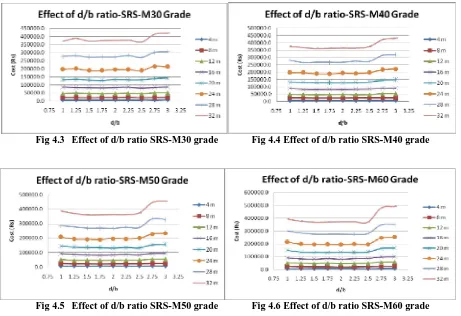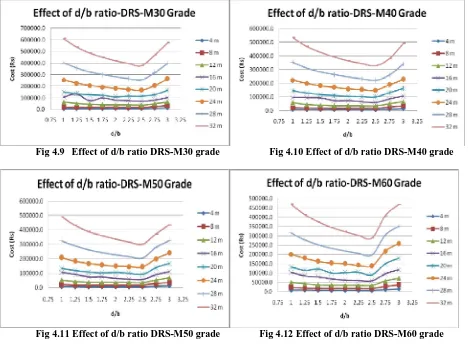Effect of d/b Ratio and Grade of Concrete in
the Economical Design of RCC Beams
P. Prakash1 , K . Jayakarthik2 , M . Narmadha3
P.G. Scholar, Department of Civil Engineering, Bannari Amman Institute of technology , Sathyamangalam, India1
P.G. Scholar, Department of Civil Engineering, Bannari Amman Institute of technology , Sathyamangalam, India2
Assistant Professor, Department of Civil Engineering, Karpagam Academy of Higher Education, Coimbatore, India3
ABSTRACT: Reinforced concrete(RCC) is widely used for construction on a large scale due to its desirable mechanical properties and flexibility of its form. In this investigation, an attempt has been made to study the various economical aspects in the design and relative cost of reinforced concrete beams of rectangular and flanged sections. Live load: 25kN/m.
Spans taken: 4m, 8m, 12m, 16m, 20m, 24m, 28m, 32m.
Grade of Concrete: M20, M25, M30, M40, M50, M60. d/b ratio: 1.00,1.25,1.50,1.75,2.00,2.25,2.50,2.75,3.00.
Reinforced Concrete Rectangular Sections and Flanged sections are designed manually, then, MS-Excel program was developed for designs. IS 456: 2000 code book was used for design.
Notations:
d = Effective depth of the section b = Breadth of the section SRS = Singly Reinforced Section DRS = Doubly Reinforced Section
KEYWORDS: d/b Ratio, Grade of Concrete, Singly Reinforced Section, Doubly Reinforced Section
I. INTRODUCTION
A reinforced concrete flexure member should be able to resist tensile, compressive and shear stresses induced in it by the loads acting on the member. Concrete is fairly strong in compression but very weak in tension. Plain concrete members are thus limited in carrying capacity by the low tensile strength. Steel is very strong in tension. Thus, the tensile weakness of concrete is overcome by the provision of reinforcing steel in the tension zone of concrete to make a reinforced concrete member. A reinforced concrete flexure member may be a beam, slab, wall or component of a foundation. The basic approach of design of flexural members is the same whereas the details may differ.
RC beams are classified as follows 1. Singly Reinforced rectangular Beams 2. Doubly Reinforcedrectangular Beams 4. Flanged Beams
Rates used for estimation:
Following rates are used for estimation of singly reinforced, doubly reinforced and flanged sections.
Concrete Rate:
M60 Grade- Rs.7300/cum
Steel Rate:
Steel – Rs.4950/kN
Formwork:
Formwork- Rs.450/sqm
II. RELATED WORK
MEBANPHIRA LYNGDOH et.al[1] investigated with the aim to optimize design of RC beams from economic and environmental aspects by using various parameters such as span by depth ratios, grades of concrete, grades of steel etc. As a case study, simply supported rectangular RC beams with a range of varying depths, steel and concrete strengths were analysed and a quantitative comparison of various aspects of design like weight, cost, safety, energy and emission rate is made to bring out the best design which is green and economically viable and they have chosen typical case to bring ideas, a conventional beam of span 4m with super imposed live load of 15kNm with various depth as allowed by code from a span/depth ratio of 8 to 20 and steel varied from Fe250 to Fe415 and concrete grade of M20 and M35 are studied and they concluded that Cost factor is less in case of M20/Fe415 at varying depths compared to M20/Fe250. And Cost factor is less in case of M35/Fe415 at varying depths compared to M35/Fe250.
III. DESIGN PROCEDURE
Singly reinforced sections, Doubly reinforced sections and Flanged sections are designed as per IS 456-2000 codal provisions.
IV. RESULTS AND DISCUSSIONS
The results on effect of d/b ratio and various grades of concrete for Singly Reinforced Sections, Doubly Reinforced Sections, Flanged Sections and comparison between Singly reinforced sections and Doubly reinforced sections are discussed below:
The following figures (Fig 4.1-4.6) shows the effect of d/b ratio for Singly reinforced sections for various grades of concrete.
Fig 4.3 Effect of d/b ratio SRS-M30 grade Fig 4.4 Effect of d/b ratio SRS-M40 grade
Fig 4.5 Effect of d/b ratio SRS-M50 grade Fig 4.6 Effect of d/b ratio SRS-M60 grade
The following figures (Fig 4.7-4.12) shows the effect of d/b ratio for Doubly reinforced sections for various grades of concrete.
Fig 4.9 Effect of d/b ratio DRS-M30 grade Fig 4.10 Effect of d/b ratio DRS-M40 grade
Fig 4.11 Effect of d/b ratio DRS-M50 grade Fig 4.12 Effect of d/b ratio DRS-M60 grade
The following figure (Fig 4.13) shows the effect of grades of concrete for Singly reinforced sections for various spans.
Fig 4.13 Effect of grades of Concrete-SRS
Fig 4.14 Effect of grades of Concrete-DRS
The following figure (Fig 4.15) shows the effect of grades of concrete for Reinforced Flanged sections for various spans.
Fig 4.15 Effect of grades of Concrete-Flanged sections
The following figures (Fig 4.16-4.21) shows the comparison between Singly reinforced and Doubly Reinforced sections for various grades of concrete.
Fig 4.18 Comparison of SRS and DRS-M30 Fig 4.19 Comparison of SRS and DRS-M40
Fig 4.20 Comparison of SRS and DRS-M50 Fig 4.21 Comparison of SRS and DRS-M60
V. CONCLUSIONS
For all grades and all spans of singly reinforced rectangular sections, there is small difference in the cost when the d/b is 1.5 to 2.5. But the ratio of 2.5 gives the most economical design (Fig 4.1 to 4.6).
For all grades and all spans of doubly reinforced rectangular sections, d/b Ratio of 2.5 gives more economical design (Fig 4.7 to 4.12).
For all spans of singly reinforced rectangular sections, M60 grade of concrete gives the most economical design (Fig 4.13).
For all spans of doubly reinforced rectangular sections, M60 grade of concrete gives the most economical design (Fig 4.14).
As the grade of concrete is increased the cost gets reduced.
For all spans of reinforced concrete flanged sections, M60 grade of concrete gives the most economical design. But the variation of cost with grades of concrete is small (Fig 4.15).
There is no significant change in the cost up to 4m span for all d/b ratios.
For all grades of concrete and all spans, singly reinforced sections is found to be more economical (Fig 4.16 to 4.21).
REFERENCES
[1]. MebanphiraLyngdoh, AkshayaChandrasenan “Optimum Green Design For Conventional RC Beam” - Proceedings of 22nd IRF International
Conference, 29th March 2015, Chennai, India.
[2]. Sanchita S. Kulaskar and S. K. Kulkarni,“Effect Of Confinement On Flexural Design Of R.C.C Beams” IJSART -volume 1 Issue 5 –May
2015-pp-282-287.
[3]. Zubin S. Mehta, Atul N. Desai and Sumant B. Patel,“Cost Optimization of Concrete Beam Element – By Direct Exhaustive Search Method”-
International Journal of Innovative Research in Science, Engineering and Technology- Vol. 4, Issue 6, May 2013-pp-305-314.
[4]. Salim T. Yousif, Ikhlas S.A. Lsafar and Saddam M. Ahmad-Iraqi, “Optimum Design of Singly and Doubly Reinforced Concrete Rectangular
Beam Sections: Artificial Neural Networks Application” - Journal of Civil Engineering Vol. 6, No. 3-pp. 1-19.
[5]. S.A. Bhalchndra and P.K.Adsul, “Cost Optimization Of Doubly Reinforced Rectangular Beam Section”- International Journal of Modern
Engineering Research (IJMER)-Vol. 2, Issue. 5, Sep.-Oct. 2012- pp-3939-3942.
[6]. P.C. Varghese , “ Limit state design of Reinforced concrete”, second edition by PHI learning Private Limited New Delhi.
[7]. Mr. R. KrishnaRaju, “Reinforced ConcreteStructures”, 3rd edition, CBSPublishers.




